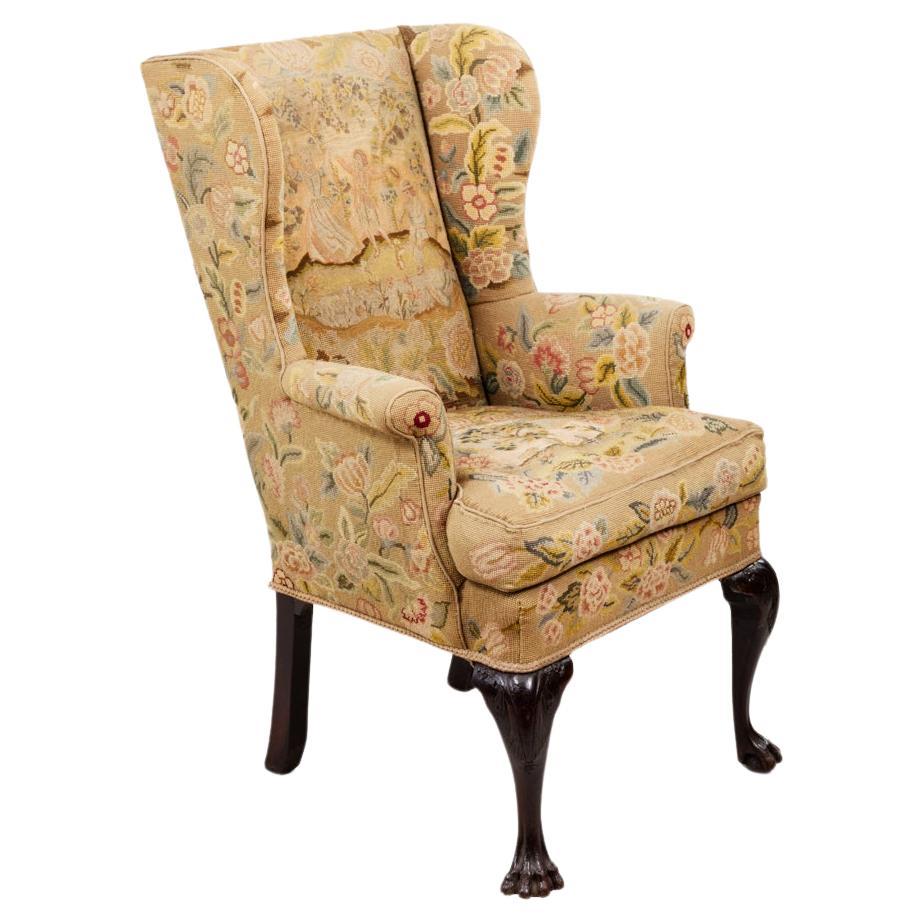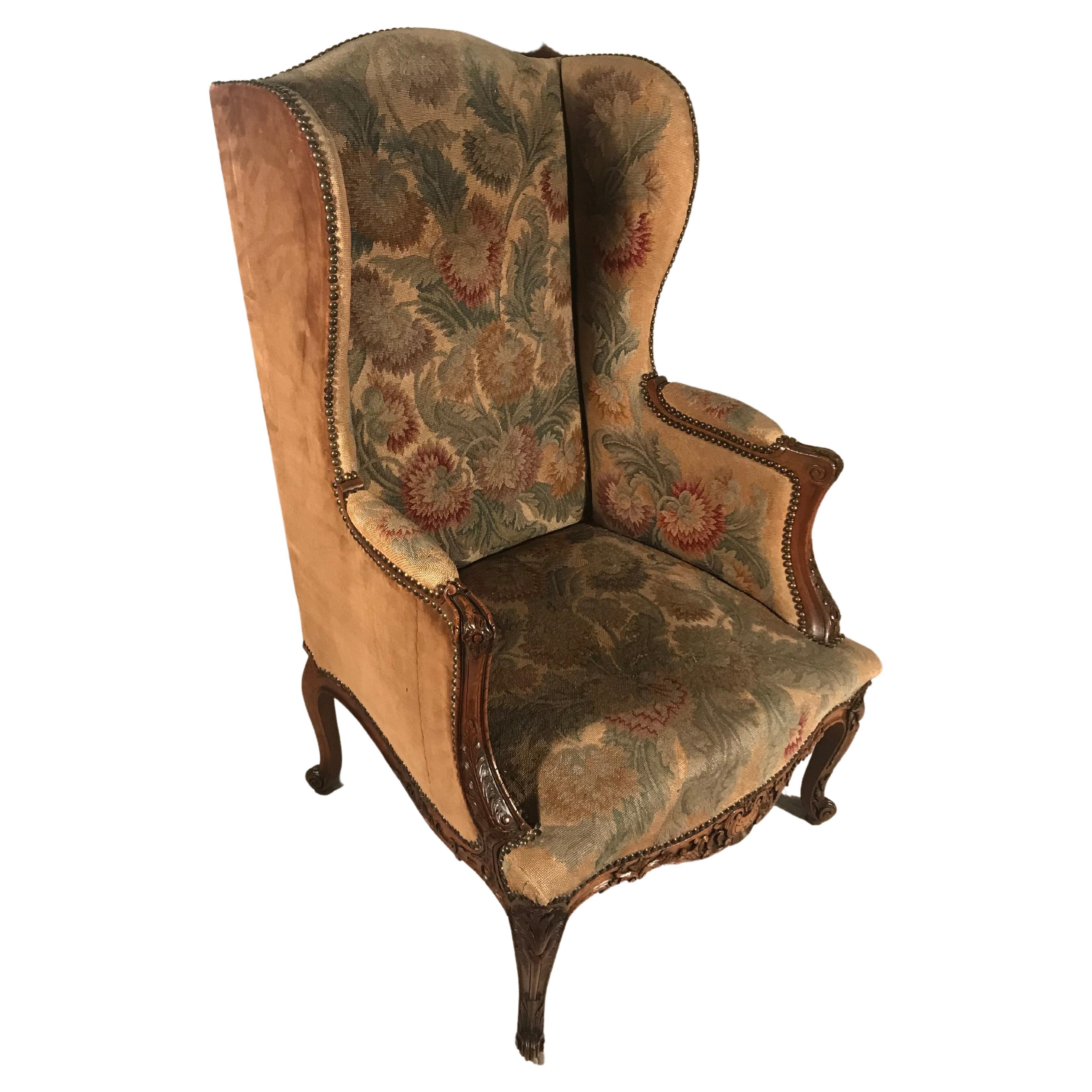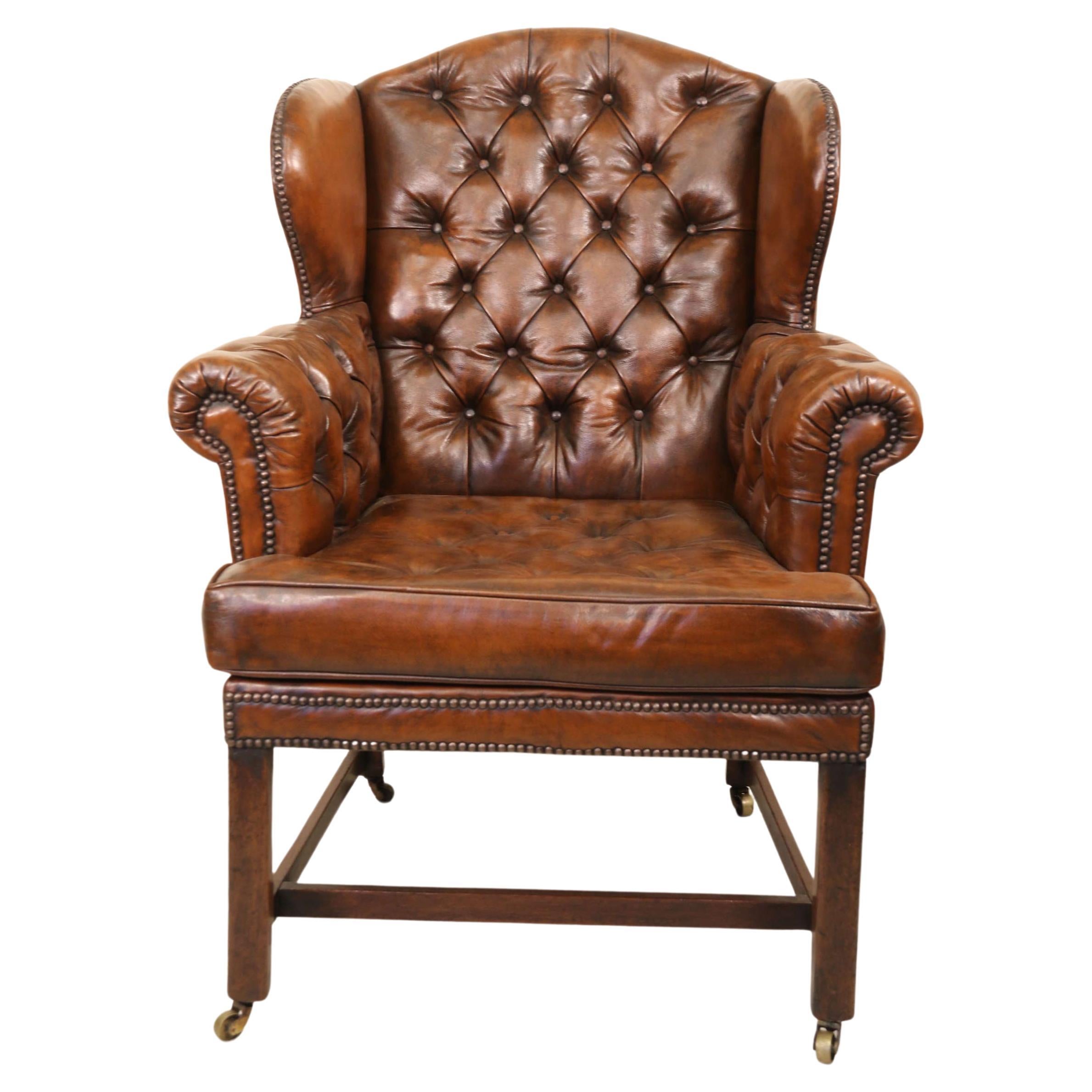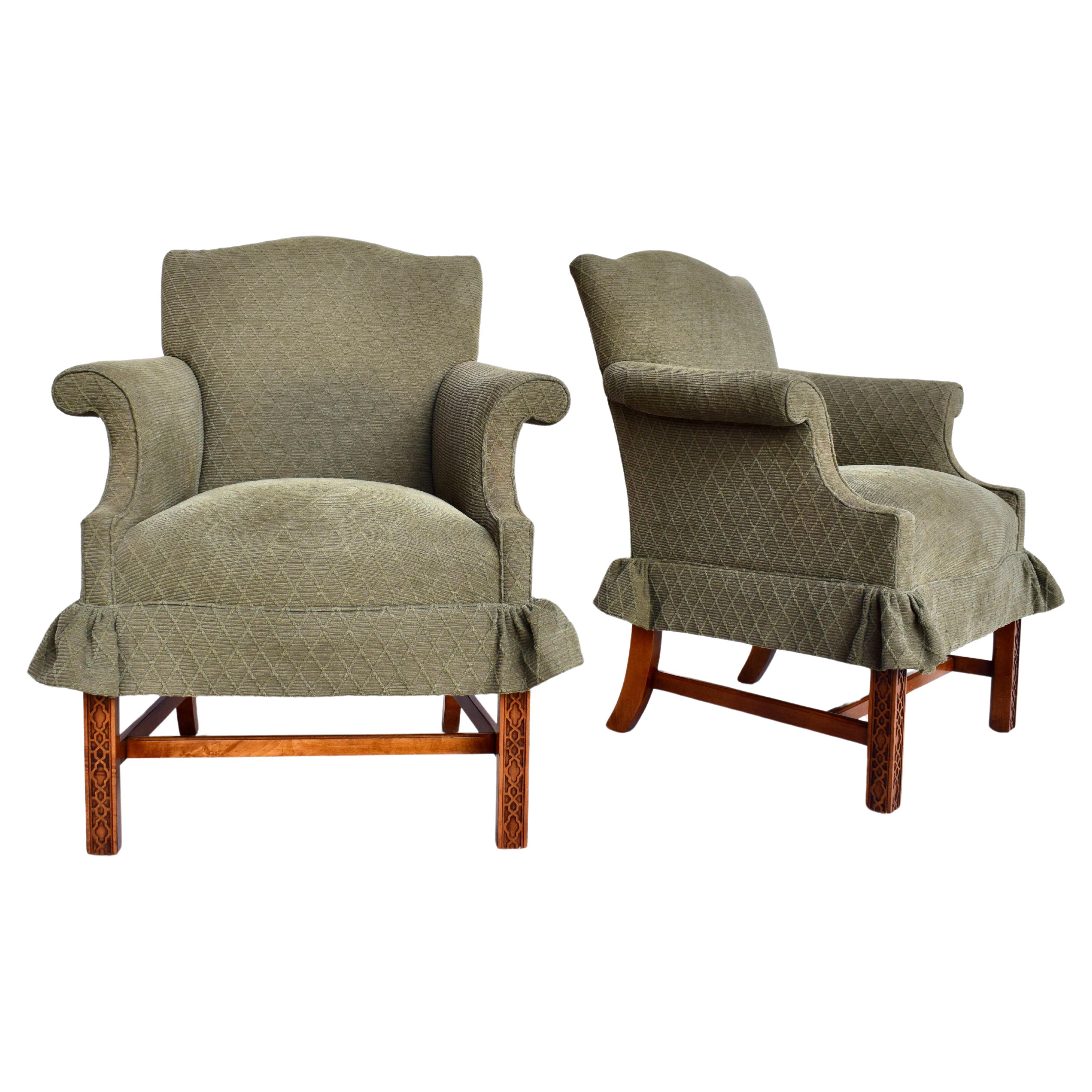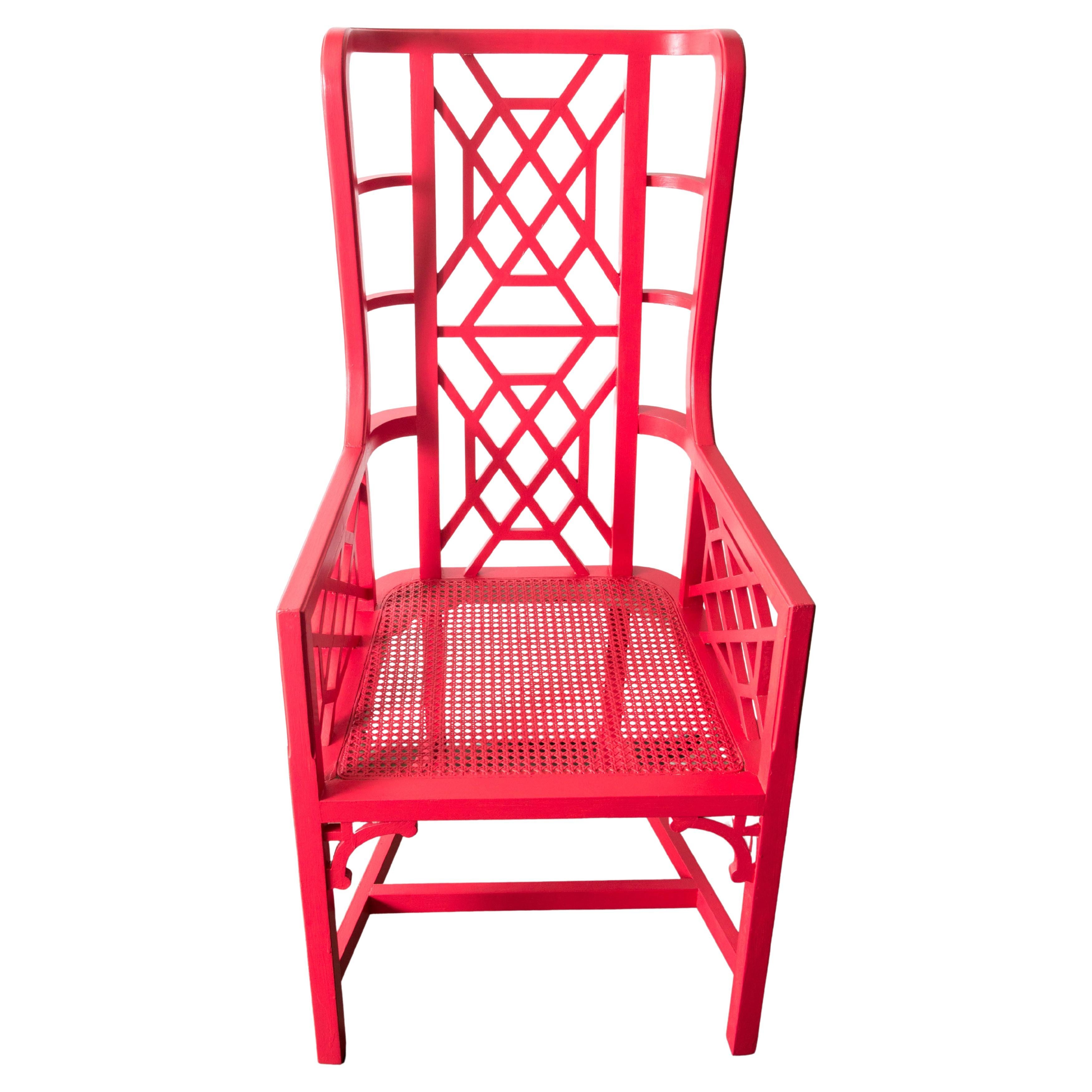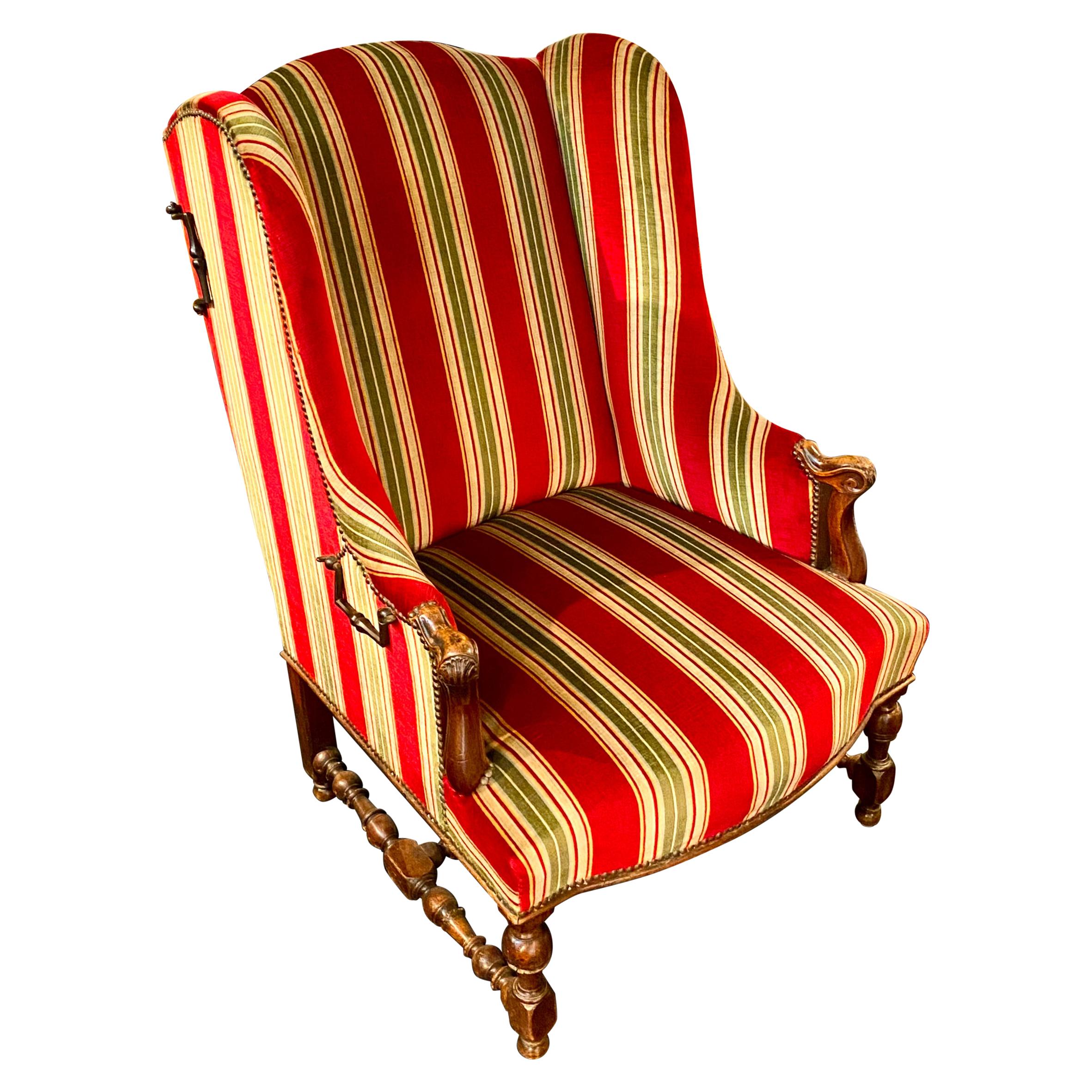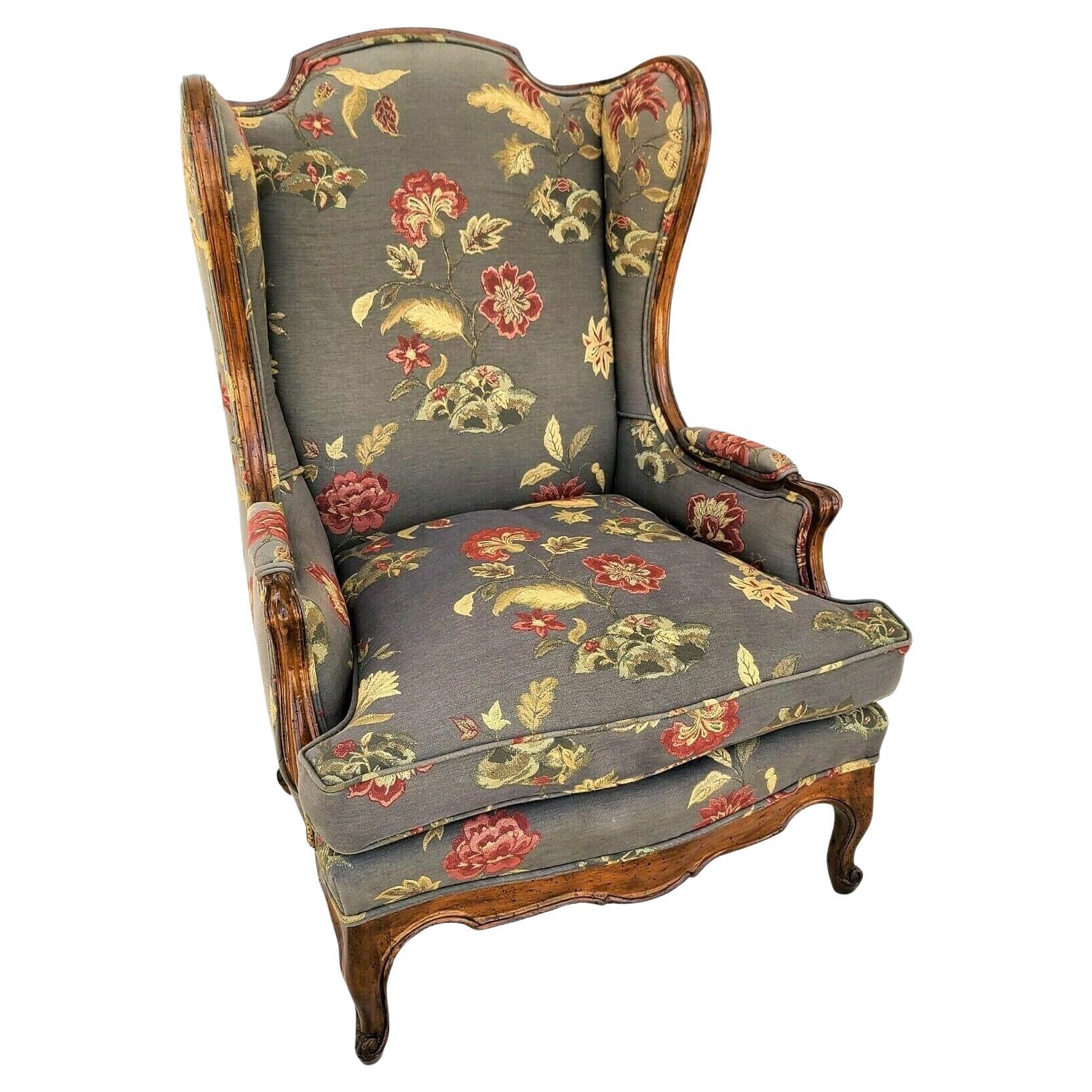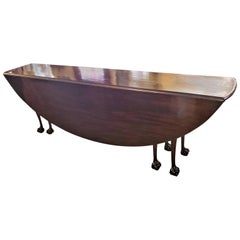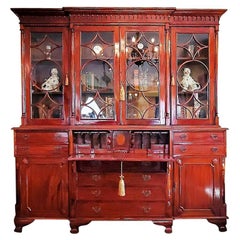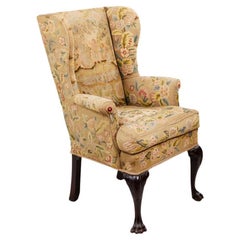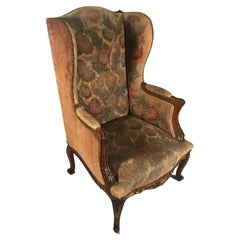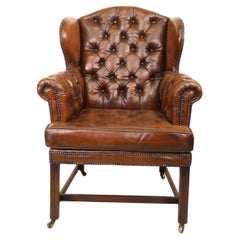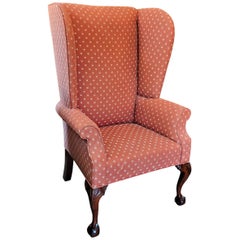
18th Century Philadelphia Irish Chippendale Style Tall Wingback Armchair
View Similar Items
Want more images or videos?
Request additional images or videos from the seller
1 of 15
18th Century Philadelphia Irish Chippendale Style Tall Wingback Armchair
About the Item
- Dimensions:Height: 49.25 in (125.1 cm)Width: 32 in (81.28 cm)Depth: 26.25 in (66.68 cm)Seat Height: 19 in (48.26 cm)
- Style:George III (Of the Period)
- Materials and Techniques:
- Place of Origin:
- Period:
- Date of Manufacture:1780
- Condition:Reupholstered. Wear consistent with age and use. Read full description for details.
- Seller Location:Dallas, TX
- Reference Number:1stDibs: LU3978122829022
About the Seller
4.9
Platinum Seller
These expertly vetted sellers are 1stDibs' most experienced sellers and are rated highest by our customers.
Established in 2015
1stDibs seller since 2018
349 sales on 1stDibs
More From This SellerView All
- 18th Century Philadelphia Mahogany Hunt TableLocated in Dallas, TXWe are pleased to present an absolutely stunning and exceptionally rare and high quality early American piece of furniture history! This table was made in the mid-late 18th century circa 1750-1790 (George III/Regency Era), and is made of solid mahogany and sits on 8 legs with exceptionally carved ball and claw feet, unmistakably in the Philadelphia style of 'Ball and Claw' carving and legs. Made of dark Cuban mahogany with secondary woods of either pine or maple. 2 drop leafs on either side supported by swinging gate legs on either side when upwards. Oval in shape and It would comfortably seat 8/10 people. Made in Philadelphia. Gorgeous original patina, dark mahogany with his gloss wax finish. This is a ‘Hunt’ Table and not to be confused with an Irish ‘Wake’ Table...Category
Antique 18th Century American George III Dining Room Tables
MaterialsMaple, Mahogany
- 18th Century Irish Georgian Cork SideboardLocated in Dallas, TXPresenting a gorgeous and very rare 18th century Irish Georgian Cork Sideboard of lovely neat proportions. Made in Ireland during the George III Era, circa 1790 and most likely made in the Southern City of Cork. A STUNNING Irish provincial piece from the Georgian Era! Made of solid mahogany, probably imported from Cuba and the secondary woods are oak (as one would expect). Beautiful dovetailing on the inside of the drawers. The ‘hints’ that this is in fact an ‘Irish’ piece are numerous. The ‘scallop shell’ on the center of the back gallery is unmistakably an Irish Georgian signature. The scalloped fans beneath either side of the central drawer are likewise an Irish signal. The shape, design and style is entirely consistent with similar pieces made in Cork at the end of the 18th Century. It has it’s original brasses which is fantastic. Lions Head Ring drawer pulls and stunning urn keyhole covers/escutheons. It has a solid gallery back splat (with central Scallop) and on both sides this ends in curved and carved scroll ends. Beneath the back splat their is a grooved plank section for holding plates etc upright. The server/counter top area is edged and banded with a carved rope style edging. The mid section consists of 3 drawers and 2 doors. The piece sits on 6 legs 4 to the front and 2 to the rear. The front legs are pillars starting at the top with an acanthus style scroll … extending down to another scroll carving directly above the reeded and fluted legs. The 2 rear legs do not have the same fluting detail. The 2 side doors open to reveal a simple one shelf storage area. One probably held a lead lined cellarette at one time. The piece is in excellent condition for it’s age and use. There are some minor aging cracks on the counter top on the left hand side. A small loss of molding to the right lower door. No original keys but we are getting replacements made. Bought in Surrey, England in 1999 by a Private Texas Collector and shipped to Texas. We have the original ‘sales invoice’ and the dealer sold it as a “Regency Mahogany Sideboard circa 1820’and told her that it was an English piece, for the sum of 3,400 GBP. Not only did the dealer not recognize the obvious ‘Irish’ signs...Category
Antique Late 18th Century Irish George III Buffets
MaterialsMahogany, Oak
- 19C Irish Georgian Style Secretary BookcaseLocated in Dallas, TXPRESENTING a STUNNING 19C Irish Georgian Style Secretary Bookcase. From circa 1850-60 and most definitely, “IRISH”. Made of gorgeous flamed Cuban mahogany which would have been imported from the British Colonies at the end of the 18th Century and early 19th Century. This piece of is of IMPRESSIVE PROPORTIONS ….. it is a real STATEMENT piece and EXTREMELY HIGH QUALITY ! It has a very ‘Regency Style’ pelmet or crown with egg and dart moldings under a very straight line crown. The top section consists of a 4 door bookcase, each with 3 shelving areas. It appears to retain it’s original glass, but it could likewise have been replaced at some time during it’s long life, as it is very rare to find pieces that have not suffered breakages over 150+ years. Each bookcase door still retains the original moldings to the front with a star shape above and below a central circular viewing panel. Each section is separated by a carved and fluted roman column/pillar. The bookcase section rests on top of the base, which consists of a beautiful central secretaire desk accessed by drop down front with working lock and key and rests on 2 pull out rests on either side. The secretary portion has a central tabernacle, with an inlaid oval satinwood medallion above another scallop shell drawer. It has 6 smaller drawers and 8 cubbies. The 2 pillars on either side of the central tabernacle are secret drawers and pull out. The curved crowns above the cubbies on either side are likewise secret drawers and pull out. Either side of the secretary there are 2 drawers (4 total) with a press or cupboard underneath. Under the secretary there are 4 large central drawers. The brasses and hardware are all original to the piece (save 2 extra hinges that have been attached to the drop down secretary to give it more support and stability. Again, each section is separated by a turned and fluted column/pillar which replicates the 2 side pillars to the central tabernacle of the secretary. The piece sits on 8 curved feet. This was an extremely high quality piece when made. This is also supported by the fact that the secondary woods are also mahogany and not pine or oak for slightly lesser quality pieces of the era. This piece is specifically identifiable as an Irish Georgian Style piece by virtue of the scallop shell moldings on the base side presses (see photos). Irish Georgian furniture...Category
Antique Mid-19th Century Irish George III Bookcases
MaterialsGlass, Mahogany, Satinwood
- 19C Set of 6 Irish Chippendale Style Ribbon Back Dining ChairsLocated in Dallas, TXPresenting a fabulous 19C set of 6 Irish Chippendale style ribbon back dining chairs. Irish made circa 1840-60. We know that these are Irish due to the signature ‘hairy paw’ feet which is synonymous with Irish Georgian furniture that were made in the Chippendale Style. These are hand crafted chairs, made of mahogany, and have fabulously detailed ‘Ribbon’ backs splats with tassel, acanthus floral and bow details. All 6 have been re-upholstered by us in a gorgeous tan/light gold silk damask fabric which is beautifully sympathetic to the style and period. We are confident that these are Early to Mid 19th Century chairs for a number of reasons: (1) The are hand crafted, (2) the color/patina is what you would expect with natural aging, (3) they have evidence of historic repairs, wear and tear consistent with age, (4) when we removed the old upholstery fabric, which looked like it was done in the 1980’s, we discovered the original ‘horse hair’ cushion filling … this practice stopped in the early 20th Century. The seat webbing was also much older and needed replacing. Fabulous acanthus carving on the knees of the front legs, with curved legs leading down to the fabulously carved hairy paws. Nice indented decoration on the front of the seat. The rear legs are undecorated and curve outwards for additional support and stability. Unsigned and unmarked but undoubtedly made by a top Irish furniture maker. probably in Dublin. Condition: Each chair has been newly re-upholstered and seat webbing replaced. The original horse hair cushion filling was cleaned and incorporated into the new cushion with modern foam to create a more comfortable and uniform seat cushion, but still retaining originality. Each chair has signs of historic repairs to the ribbon back splats over the generations. This is not unusual due to the somewhat delicate nature of these types of back splats. Also, it is an indicator of true age. The chair to the back left in the main photos has had the most repairs and much more recently performed (by us) as the back splaty was broken in 2 places (but we had the original pieces) and the chair needed the insertion of metal pins to secure the repaired sections. We have provided a couple of photos of this back splat which you can see evidence of the repairs. The repairs are very professionally done and the chair is now fully functionable and usable and the repairs are not very noticeable. These repairs are reflected in the pricing, as, if these chairs were ‘mint’ they would be very valuable and expensive ! Irish furniture can be recognised by certain features, which differentiate it from its European counterparts. The Irish style of furniture is said to have been lagging behind in fashion compared to English equivalent by a number of years, in both its design and manner by which the furniture was manufactured. A defining feature of the mid-eighteenth-century furniture is the carving on different parts of the furniture such as the aprons, blanket chests, bottle-stands and such objects. The carvings included foliated details, baskets of flowers and scallop shells, which are some of the most prominent carvings that are represented on Irish furniture at this time. A few of the Irish makers of these objects were James Hicks, Arthur Jones, William Moore, Mack & Gibton and Robert Strahan. All though individuals would have been the most prominent at the time of the 18th century and early 19th century but there are any other cabinet makers as well. Not all Irish furniture was detailed with such wonderful carvings and some might have been seen to be rather plain. One of the most identifiable items that are described as plain is the Irish Hunt Table, its simple elegance comprising of with straight plain legs. It was most commonly used in the dining room of a rural house such as a agents house or large house of a land holder. Another very popular and simply designed piece was the Irish Silver table, its design is very elegant and yet individual partially owing to the shell motive. Other examples of such Irish tables are side tables which have a distinctive double scrolled leg. Usually legs are carved with acanthus and have paw feet which are quite popular in Ireland but more rare in England. Other features are the inside leg which is carved with elongated C-scroll. The triple scroll on the leg was common place. Some cabinet makers and creativity was really captured with their side tables in how the carving was done. This carving may include Jupiters eagle or Lion mask and flanked Swags of flowers. In other furniture such as chairs, the H-shaped serpentine stretcher was popular in the 18th century in Ireland and when English chairs had moved forward in their design the Irish makers were still using the H-shaped serpentine. There was certainly an overlap between Irish and English furniture, one can see that Irish cabinet makers used English pattern books but used Irish features such as the carvings as the shell, baskets of flowers and foliated details. Another unique feature in Irish cabinet making was Killarney ware...Category
Antique Mid-19th Century Irish Chippendale Dining Room Chairs
MaterialsMahogany
- Early 20C Irish Georgian Style Mahogany Low Boy.Located in Dallas, TXPRESENTING A LOVELY Early 20C Irish Georgian Style Mahogany Low Boy. VERY NICE Irish Mahogany Low Boy, chest of 3 drawers, on stand. Additional drawer on stand, making 4 drawers in...Category
Early 20th Century Irish George III Commodes and Chests of Drawers
MaterialsBrass
- 18C English Chippendale Shepherds Crook ArmchairLocated in Dallas, TXPresenting an absolutely stunning and original 18C english chippendale shepherds crook armchair. Made in England circa 1780-1800 of walnut, this ‘period’ chair is simply Gorgeous in it’s Originality! It is still covered in it’s original needlepoint/tapestry upholstery with neo-classical elements of a Greek or Roman Goddess sitting holding a staff on the back splat and floral motiff’s elsewhere. What makes this piece Truly Original is the fact that the needlepoint appears to have been signed by the original owner/maker of the tapestry and it appears to be the family name of “Tancret”. The arm rests have the most glorious ‘shepherd’s crook’ twists and turns. The central base section has what appears to be heavily carved Prince of Wales Plumes, signifying the Regency Era. The knees of the 2 front legs have the most amazingly carved acanthus relief decoration and the 2 front legs end in the best example of ball and claw feet you are ever likely to see. The back legs also have some interesting detail as the feet are platformed or hooved. Overall, the piece is in great condition for it’s age and use. There are no major tears or holes in the original tapestry. There is some discoloration but that is to be expected with a piece this old. There is a very small piece of the central front medallion (bottom left as you look) missing, but it is not noticeable and does not detract from the piece. One small stain on the back. Gorgeous natural patina to the wood. Provenance: From a Wealthy Estate in Kentucky/Tennessee Condition: Very good. See full description. Dimensions: 44? tall, 28? wide and 27? deep Seat height of 18.5? with seat depth of 17.5? and interior seat width of 22.5? Armrests are 26.25? Tall The vast movement of people that followed the Norman Conquest of England in 1066 brought the Tancret family name to the British Isles. Tancret comes from the ancient Norman given name Tancred. The Tanksley variant is indeed rare. However, this name traces its origin to Roger Tankerlayman who was listed in Yorkshire in 1387. Because of this political and religious unrest within English society, many people decided to immigrate to the colonies. Families left for Ireland, North America, and Australia in enormous numbers, traveling at high cost in extremely inhospitable conditions. The New World in particular was a desirable destination, but the long voyage caused many to arrive sick and starving. Those who made it, though, were welcomed by opportunities far greater than they had known at home in England. Many of these families went on to make important contributions to the emerging nations of Canada and the United States. Analysis of immigration records indicates that some of the first North American immigrants...Category
Antique Late 18th Century English Chippendale Armchairs
MaterialsTapestry, Walnut
You May Also Like
- 18th Century Irish George II Wingback ArmchairLocated in Dublin 8, IE18th Century Irish George II wingback armchair featuring carved cabriole legs terminating in lion paw feet to the front, and simple legs to the back. The chair is covered in needlewo...Category
Antique 18th Century Irish George II Wingback Chairs
MaterialsTapestry, Mahogany
- Baroque Wingback Armchair, Germany 18th centuryLocated in Leimen, DEIntroducing an exquisite Baroque wingback armchair that transports you back to the elegance of the 18th century. This remarkable piece, originating from Germany around 1760, showcase...Category
Antique 1760s German Baroque Wingback Chairs
MaterialsWalnut
$2,948 Sale Price25% Off - 18th Century Large Leather Upholstered Wingback Armchair, GeorgianLocated in Central England, GB18th Century Large Leather Upholstered Wingback Armchair, Georgian This handsome and larger scale George iii wing backed armchair has recently been fi...Category
Antique 18th Century English Georgian Wingback Chairs
MaterialsLeather
- 18TH CENTURY CLAW & BALL FEET CARVED ANTiQUE WINGBACK ARMCHAIR FRAMELocated in GBRoyal House Antiques Royal House Antiques is delighted to offer for sale this stunning, stripped back circa 1780-1800 Georgian Claw & Ball carved wingback armchair frame Please not...Category
Antique 1780s English Georgian Wingback Chairs
MaterialsHardwood
- Chinese Chippendale Style Upholstered Wingback Chairs- PairBy Henredon, Baker Furniture Company, Hickory Chair Furniture CompanyLocated in Southampton, NJA pair of very sweet George III Chippendale style armchairs in Sage green textured diamonds Chenille upholstery with Chinese Chippendale fretwork to the Mahogany bases with H stretch...Category
Late 20th Century American George III Wingback Chairs
MaterialsChenille, Mahogany
- Chinese Chippendale Wingback ArmchairsLocated in Lake Worth, FLFor FULL item description click on CONTINUE READING at the bottom of this page. Offering One Of Our Recent Palm Beach Estate Fine Furniture Acquisitions Of A Pair of Fabulous Chi...Category
Late 20th Century Chinese Chippendale Wingback Chairs
MaterialsCotton, Wood
$2,995 / set
Recently Viewed
View AllMore Ways To Browse
20th Century Felt Armchairs
Philadelphia Chippendale
Ball And Claw Foot Chairs
Chippendale Wingback Mahogany
Johnson Chair Co
Late 20th Century Pine Chairs
Chippendale Style Wingback Chair
Used Furniture Phila
Antique Furniture Philadelphia Pa
Irish Georgian Chairs
19c Carved Chairs
Chippendale Wingback Chair Antique
Georgian Style Wingback Armchair
Antique Ball And Claw Foot Chair
Irish Chippendale Chair
Georgian Chippendale Ball And Claw
18th Century Philadelphia Chair
Chippendale Wingback Chair Period
